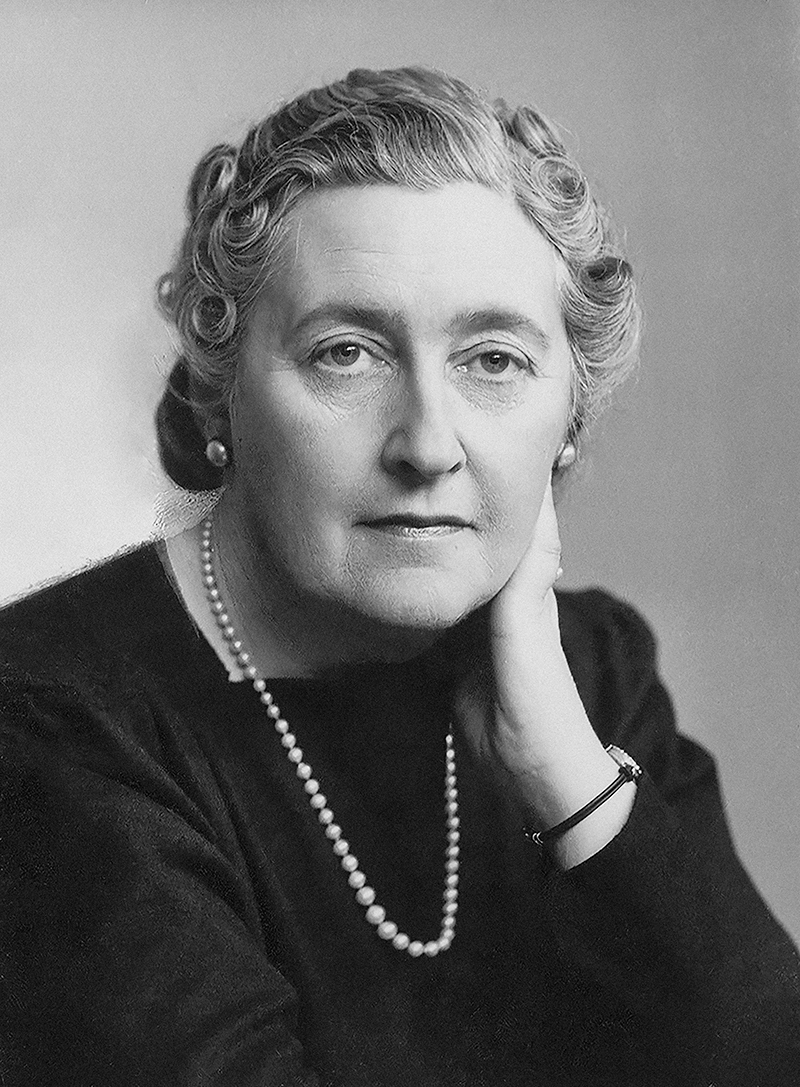After Nearly a Century, Officials Say Agatha Christie’s Mysterious Disappearance Has Finally Been Solved
It’s the kind of story that feels more like fiction than fact—fitting, perhaps, for the woman who defined modern detective storytelling. In 1926, the world’s best-known mystery author, Agatha Christie, vanished without explanation. Her sudden disappearance, under strange and troubling circumstances, triggered a nationwide search, drew global headlines, and puzzled even the most brilliant minds. For nearly a century, the mystery remained unsolved. But now, according to officials, new insights and historical analysis may have finally unraveled the truth behind one of the most intriguing vanishing acts of the 20th century.

To understand the depth of this mystery, we must start with Agatha herself.
Born on September 15, 1890, in the quiet seaside town of Torquay, England, Agatha Mary Clarissa Miller was the youngest child in a comfortable upper-middle-class household. Her upbringing was unconventional. Her mother, Clara, believed children should not learn to read too early, fearing it would overwhelm their minds. But young Agatha, always curious and self-motivated, taught herself to read by age five—setting the tone for a life defined by independent thought and a fierce intellectual drive.
Her early years were marked by both whimsy and hardship. Agatha’s father, a kind but financially unstable man, passed away when she was just 11. The loss deeply affected her and would echo in the emotional landscapes of her novels. Though her formal education was scattered—mostly home tutoring and brief study in Paris—Agatha developed a sharp observational skill and a love for storytelling.
In her early twenties, she began writing, submitting poems and short stories to little acclaim. But in 1916, her sister Madge challenged her to write a detective novel. Rising to the occasion, Agatha crafted The Mysterious Affair at Styles, introducing the world to Hercule Poirot, a meticulous Belgian detective whose logical mind would become iconic. The book was eventually published in 1920, launching a literary career that would change crime fiction forever.

Amid this rise, Agatha’s personal life was equally eventful. In 1912, she met Archibald “Archie” Christie, a Royal Flying Corps officer. Despite warnings from her mother about his character, Agatha married Archie in 1914. While he served in World War I, she worked as a nurse at a Red Cross hospital, where her work in the dispensary sparked a lifelong interest in poisons—a theme that would become a hallmark of her mystery novels.
Their daughter, Rosalind, was born in 1919, and while the family life looked stable from the outside, trouble loomed beneath. Archie’s distant nature and Agatha’s own growing literary success began to strain their marriage. In 1926, Archie revealed he was having an affair with a woman named Nancy Neele. Days later, Agatha disappeared.
Her car was found abandoned near a chalk quarry. The trunk held her belongings, but she was nowhere to be found. For eleven days, Britain was gripped by the search for the missing author. Thousands of volunteers combed the countryside, and public speculation ran wild. Was it a publicity stunt? A nervous breakdown? Foul play?
When Agatha was finally located, she had checked into a hotel under a false name—using the surname of her husband’s mistress. She claimed to have no memory of how she got there. Though she never spoke publicly about the incident, psychologists at the time suggested she may have suffered a fugue state, triggered by emotional trauma.
Despite this explanation, many found the details too strange to accept at face value. Why the false name? Why leave her car behind? And why had she staged her disappearance so meticulously?
Over the years, countless theories emerged. Some believed it was a calculated act of revenge against Archie. Others saw it as a cry for help, or even a genuine psychological breakdown. But until now, no official consensus had been reached.

Today, nearly 100 years later, a team of historians, psychologists, and literary scholars claim to have reached a plausible conclusion. Drawing from personal letters, hospital records, and previously unpublished interviews with contemporaries, they argue that Agatha did indeed experience a dissociative fugue—a rare psychological condition triggered by acute stress, grief, or trauma.
In 1926, Agatha faced multiple devastating events within a short span: the death of her mother, the collapse of her marriage, and intense public pressure from her growing fame. Experts now believe these factors overwhelmed her emotionally, leading her mind to temporarily shut down and construct a new identity as a way of escaping unbearable reality.
This would explain the confusion she later expressed, her use of an alias, and her apparent calm demeanor at the hotel. According to Dr. Sarah Fineman, a psychologist involved in the recent research, “Her behavior is consistent with what we now recognize as a dissociative fugue. Back then, the condition was barely understood. Today, we know that the brain can compartmentalize traumatic stress in extraordinary ways.”
Agatha eventually recovered and returned to her life, continuing to write prolifically and rarely speaking of the incident. The event, however, left a lasting mark on her public image. It also fueled public fascination with her life—a fascination that endures to this day.

The disappearance, though now possibly “solved,” remains a remarkable reflection of the pressures she endured. Her personal mystery mirrored the themes she explored in fiction: identity, deception, and the hidden motives of the human heart. And even though the facts may now be clearer, the mystique surrounding that chilly December night in 1926 still lingers.
Agatha Christie would go on to become the best-selling novelist in history, with more than two billion copies of her works sold. She created beloved characters like Miss Marple and Hercule Poirot, and helped define the golden age of detective fiction. Her legacy lives on not just in her books, but in the enduring intrigue of her own life.
Now, almost a century later, the mystery of her disappearance may finally have its answer—not in fiction, but in the quiet and complex truth of being human.
News
MSNBC thought they could destroy Katie Phang’s career by canceling her weekend show, but Rachel Maddow was never going to let her friend fall into ruin. Under the protection of the person who MSNBC wouldn’t dare touch, Phang quickly attracted hundreds of thousands of viewers with her very first YouTube video after leaving the network. The MSNBC executives promptly extended her a new job offer—but Phang’s self-assured response left them humiliated.
You ever see someone get fired and then become 10x more powerful the minute they walk out the door? Yeah,…
SHOCK : ABC IN CRISIS: The View Yanked Off Air After Explosive Confrontation With Tyrus—Network Refuses to Explain Vanishing Act as Fans Demand to Know What Was Said When the Cameras Went Dark
Okay, so… what the actual hell just happened at The View? One second they’re doing their usual morning chaos—Joy snarking,…
THIS JUST HAPPENED: Karoline Leavitt calls Brittney Griner a ‘shit’ after discovering the truth about her gender. In a surprising and controversial move, the Women’s National Basketball Αssociation (WNBΑ) has announced that it will implement mandatory sex testing for all players starting next season. This decision comes amid discussions surrounding gender identity and inclusivity in women’s
Alright y’all, buckle up, because this isn’t just some spicy locker room drama. No no, this is the kind of…
Karoline Leavitt Drops One Line That Leaves The View in Total Shock — Even the Hosts Froze. It wasn’t loud. It wasn’t angry. It was cold, sharp, and straight to the point. One sentence — that’s all it took for Karoline to say what millions have been thinking for years.
Title: Karoline Leavitt vs. The View — And the One-Liner That Nuked Daytime TV Whew. Somebody hand Whoopi a glass…
FOX News Goes Full Savage: Jesse Watters Leads Ruthless Multi-Billion Dollar War to Annihilate CBS, ABC, and NBC in the Most Shocking Media Power Grab of the Decade—Legacy Networks Are Panicking, and the Future of TV May Never Be the Same
Alright y’all, buckle up because this ain’t your average cable news drama. FOX News didn’t just throw hands with the…
“IS BRITTNEY GRINER A MAN?!”—Viral Video Ignites FIRESTORM, Fans Lose It Over Bizarre Clip!
Brittney Griner, WNBA star and outspoken advocate, is no stranger to controversy — but her latest social media post has…
End of content
No more pages to load












